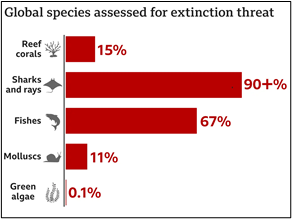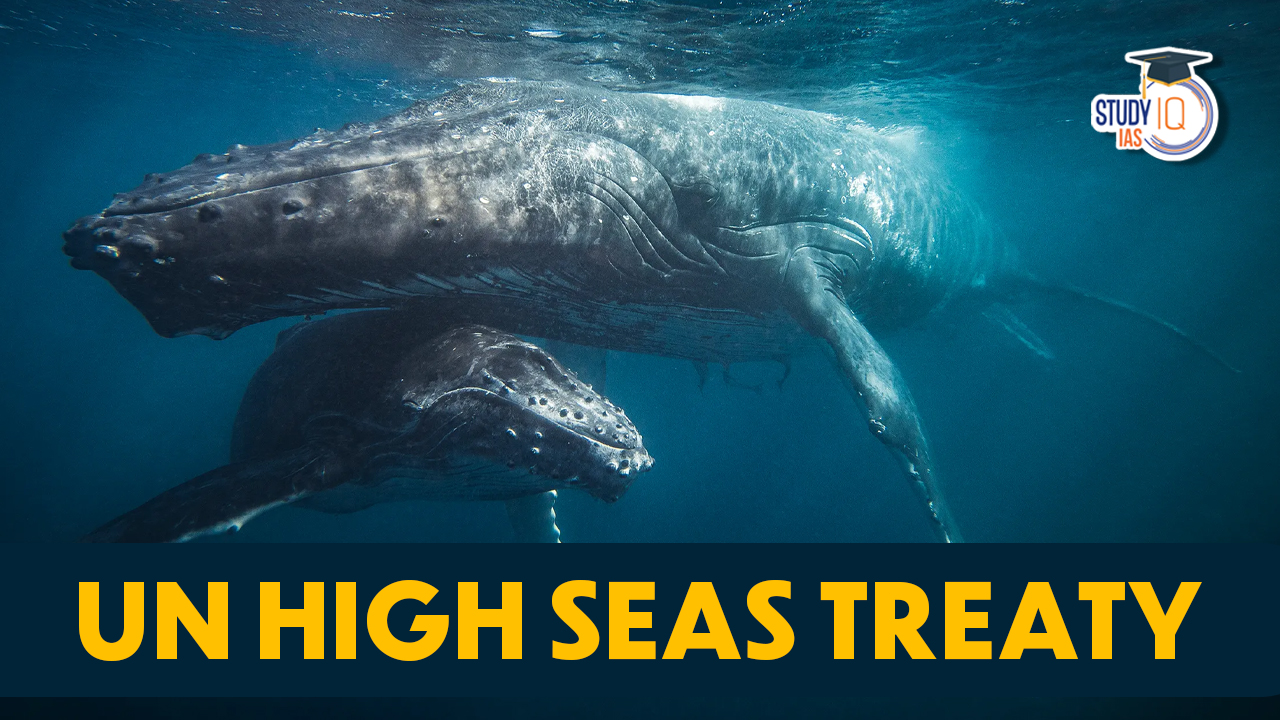Table of Contents
Context: India is unlikely to ratify the ‘High Seas Treaty’ at the upcoming U.N. Ocean Conference.
What are High Seas?
- High seas are areas of oceans that lie beyond countries’ national waters (beyond 200 nautical miles).
- These are the largest habitats on Earth and are home to millions of species.
- High seas comprise more than 60% of the world’s oceans and nearly ½ of the planet’s surface.

About High Seas Treaty
- Officially titled the “Agreement on the Conservation and Sustainable Use of Marine Biological Diversity of Areas Beyond National Jurisdiction (BBNJ)”, commonly known as the High Seas Treaty.
- It is a new international legal framework under UNCLOS (United Nations Convention on the Law of the Sea) aimed at protecting ocean ecosystems that lie beyond national jurisdictions.
- It is the third implementing agreement under UNCLOS, following the last one in 1982.
- Main Negotiators: EU, US, UK, and China played lead roles.
- Supports the 30×30 goal: Protect 30% of land and sea by 2030.
- Legally safeguards two-thirds of the ocean, covering over 40% of Earth’s surface.
- Crucial for endangered marine species and coastal livelihoods.
Key Objectives
- Marine Conservation
- Equitable Benefit Sharing
- Capacity Building & Technology Transfer
- Create Marine Protected Areas (MPAs).
- Set rules for Environmental Impact Assessments (EIAs) in international waters.
Why It’s Needed
- Only 2% of high seas are currently protected.
- 10% of marine species face extinction risks.
- Threats include overfishing, deep-sea mining, acidification, and pollution.
- Calls for such a treaty have existed for over two decades.
Objectives and Framework of the BBNJ Agreement
- Adopted in March 2023.
- It serves as the third implementing agreement under the United Nations Convention on the Law of the Sea (UNCLOS).
- It is a first-ever treaty to protect the world’s oceans that lie outside national boundaries.
- Its primary objectives include:
- Conserving Marine Biodiversity: Establishing measures to protect diverse marine life.
- Equitable Sharing of Benefits: Ensuring that profits derived from marine genetic resources are shared fairly among nations.
- Environmental Impact Assessments (EIAs): Mandating assessments for activities that may harm marine ecosystems.
- The treaty prohibits nations from claiming sovereign rights over high seas resources and promotes international cooperation in managing these areas.
| United Nations Convention on the Law of the Sea (UNCLOS) |
|
Need for the High Seas Treaty
- The world’s oceans provide oxygen that sustains human and animal life, drive weather systems and store about one-quarter of the planet-heating carbon dioxide generated by human activities.
- According to the Red List of Threatened Species by IUCN, nearly 10 per cent of underwater plants and animals assessed so far are threatened with extinction.
- According to the World Wildlife Fund (WWF), a third of species, such as sharks and rays, are at risk of extinction.
- According to NASA, 90% of global warming is occurring in the ocean.
- Effects of ocean warming include sea level rise due to thermal expansion, coral bleaching, accelerated melting of Earth’s major ice sheets, intensified hurricanes, and changes in ocean health and biochemistry.
- Currently, there is no treaty for conserving the health of vast swathes of the Earth’s oceans,
- Only 1.2% of international waters are protected, and only 0.8% are identified as “highly protected.”

Challenges to the High Seas Treaty
- Lack of Implementation Roadmap: Out of 104 signatories, only 14 have ratified the treaty, far from the 60 required for enforcement.
- Geopolitical rivalries, especially in the South China Sea and the Bay of Bengal, hinder consensus on establishing Marine Protected Areas (MPAs).
- Contentious Provisions: The treaty mandates profit-sharing from marine genetic resources via a global fund.
- Critics highlight potential exploitation by wealthier nations, citing the absence of robust accountability mechanisms.
- Conflicts with Other Regimes: Potential overlap with existing frameworks, like the Convention on Biological Diversity, risks fragmenting enforcement and disadvantaging smaller states.
- Capacity-Building Challenges: Low and middle-income nations lack resources for equitable participation in ocean science and governance.
- The treaty lacks enforceable measures to ensure capacity-building and technology transfers.
- Overlooking Ecosystem Interconnectedness: The treaty’s focus on the high seas ignores the cascading effects of harmful activities in Exclusive Economic Zones (EEZs):
- Example: The 2021 X-Press Pearl disaster off Sri Lanka caused widespread marine pollution.
- Overfishing in West African EEZs depletes fish stocks beyond national jurisdictions.
- Gaps in Regulation: Fails to address oil and gas exploration impacts within EEZs, a significant economic interest for many states.
- Lack of international review for EIAs limits the treaty’s enforcement framework.
India and the High Seas Treaty
- India is unlikely to ratify the High Seas Treaty (BBNJ) at the ongoing UN Ocean Conference in Nice, France.
- India signed the treaty in September 2024, but formal ratification is still pending.
- Amendments to the Biological Diversity Act are required before ratification — expected after the Monsoon Session (July 12–Aug 12).
- As of June 10, 49 countries have ratified the treaty; it will take effect after 60 ratifications.
- India highlighted its marine initiatives:
- Samudrayaan mission: trial dive to 6,000 metres by 2026.
- $80+ billion invested in the Blue Economy.
- Called for a Global Plastics Treaty.
- Launched ‘SAHAV’ digital ocean data portal.
Why India Has Concerns About Ratifying the High Seas Treaty
- Equity Concerns: India seeks fair sharing of marine genetic resource benefits with developing countries.
- Commercial extraction from the high seas is difficult, and benefit-sharing rules are still under negotiation.
- Implementation Issues: Practical enforcement of EIAs and MPAs in international waters is challenging.
- Ratification Delay: India is aligning the treaty with domestic laws before formal ratification.


 America’s Plan to Manage AI Proliferat...
America’s Plan to Manage AI Proliferat...
 Monasteries in India: List of Major and ...
Monasteries in India: List of Major and ...
 National Doctor’s Day 2025: History, T...
National Doctor’s Day 2025: History, T...





















